#034
WellComp: Human-friendly
Enabling Technology
for New Well-being
Tadashi Okoshi
Japanese Color:OUNI-iro
#034
Tadashi Okoshi
Japanese Color:OUNI-iro
MOVIE

Associate Professor
Faculty of Environment and Information Studies
IT and AI technologies have been developed with the main focus placed on increasing speed, capacity, and number of computers. However, as the notion of ubiquitous computing has now been realized to the extent that we are drowning in a flood of information and services, there are mounting needs for more human-friendly computing. Tadashi Okoshi, an associate professor whose research theme is “human-centered computing,” has advocated “WellComp” (“Computing for Well-being”), or computing based on IT and AI technologies aimed at promoting people’s health and welfare. Through this research, he has been pursuing well-being in the age of the 100-year life.
Other than smartphones, smartwatches, smart speakers, and many other devices that we tend to keep close at hand, we are seeing a wider range of things we use—home appliances, office equipment, and even automobiles—being equipped with information processing capabilities and connected to networks. The pervasiveness of such processing and connectedness is called ubiquitous computing. The massive amounts of data obtained from these objects are analyzed, and the results are utilized as added value for a wide variety of services that enrich our lives, such as in the areas of healthcare, medical care, education, transportation, entertainment, and leisure.
However, while the volume of data available for use is being exponentially amplified due to the progress of ubiquitous computing, the capacity of people to deal with data is not increasing at the same rate. The flood of information coming in is overloading people, leaving them no longer able to handle it. Even when a large volume of data collected from sensing devices is able to be analyzed, it will be wasted if no person ever sees or uses it. Although this problem of “information loss” is not yet widely recognized, it is becoming a serious challenge for the future of computing. Technologies to make up for the limited capacity of people to accommodate the increasing volumes of information must be pursued.
The human life span has been extended due to various factors including advances in healthcare and medical care, and we are now living in the so-called age of the 100-year life. “Well-being” is a concept describing a physically, mentally, and socially healthy condition, and “WellComp” is a type of computing based on technologies geared toward achieving the well-being of people in the age of the 100-year life.
One of the core WellComp technologies is sensing technology for knowing about humans. The technology is designed to capture data on various aspects of people’s lives that range very broadly from actions (walking, eating, sleeping, etc.), daily living (dietary habits, sleep, exercise, etc.), and behaviors (learning, hobbies, art activities, keeping animals, etc.) to include even inner mental conditions (feelings, emotions, mood, etc.). More technically, sensing technology enables the collection of big data on these aspects of human life from mobile, wearable, and Internet of Things (IoT) devices, sensors, websites, and other sources. At our laboratory, this sensing technology is coupled with machine learning technology to develop recognition technologies.
Sensing technology can also be applied widely in many services ranging from health and medical care to public infrastructure, education, and leisure. For instance, patients using anticancer drugs are prone to suffer from numbness in the limbs as a side effect of the drugs and so have a risk of falling over, even on at surfaces, and thereby sustaining a fracture. For such patients, sensing technology can be used to collect data from their smartwatches or smartphones so that falls can be prevented before they happen through the detection of any signs of numbness, such as staggering, using machine learning technology
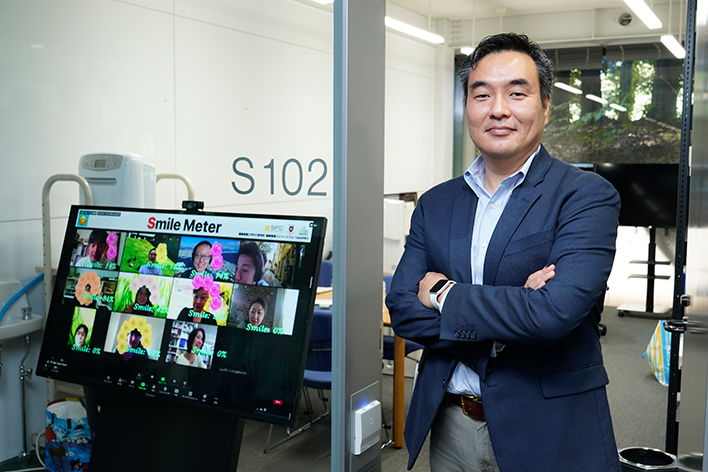
After knowing about humans using sensing and recognition technologies, the next step is analyzing the big data captured. The results of the analysis become new knowledge that can be used as valuable output data. For instance, while the thermometer function of smartphones only shows temperature, its data can become valuable in other ways when used with location information or information on the status of Wi-Fi connections or when connected with AI technology.
Data from sensing devices, such as that on human behaviors and actions, is not the only useful data we can obtain. We can also gather and analyze data about how people usually use the Internet, for example.
In our joint research with Yahoo Japan Corporation, we are collecting data every day on the words input and searched by approximately 10 million people on the Yahoo! search page and, by adopting a machine learning model, we can observe changes in the “mood” (emotional changes) of Japanese society on a daily basis. Also, in our research on mental health and social media, it is becoming clear that the frequency and duration of using social media of each individual and the degree of utilization of each service, such as Facebook, Twitter, Instagram, and LINE, by each individual are related to their level of well-being and mental health (sense of loneliness, etc.). We are trying to understand this is more detail.
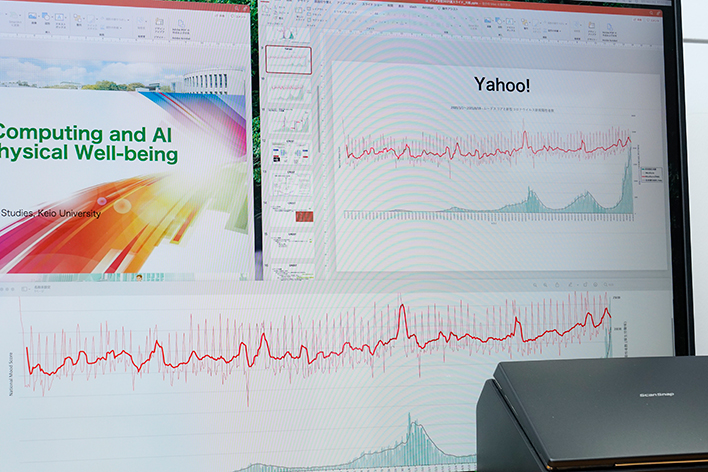
While smartphones receive and display numerous push notifications, such as new messages and breaking news, many of these are overlooked and not acted upon. We humans are often driven by our emotions, which can make it difficult for us to remain rational in our attempt to achieve a goal. For instance, even when your fitness app sends you a notification saying that you need to go for a walk to achieve your goal of losing five kilograms, as a human being you may be tempted to not do it, making excuses such as “it’s raining” or that you are simply “not in the mood.”
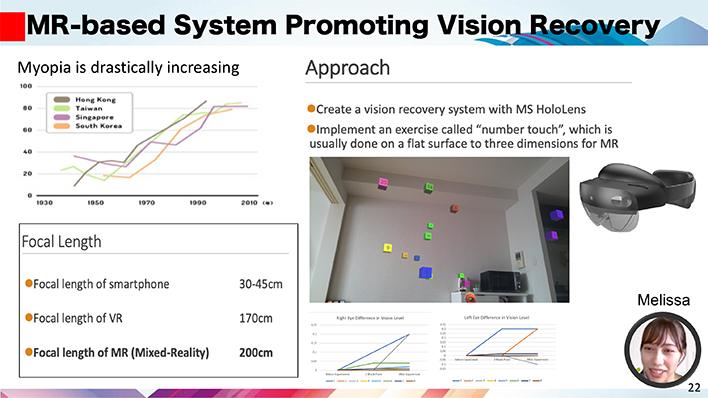
What this means for information system designers is that simply displaying a message like “Walk for 30 minutes” cannot effectively change users’ behavior. For this reason, a research project is currently underway that explores ways to manage human attention, which involves the development of context-aware technology to identify, using AI, the best circumstances or timing for displaying notifications for each user, as well as the development of technology for generating effective wording and voice. Our major future challenge is to create a mechanism that factors in the circumstances and psychology of each user at any given time and identifies the best possible ways to present information (in terms of timing, modality, wording, strength, etc.) in order to encourage a smooth transition in user behavior.
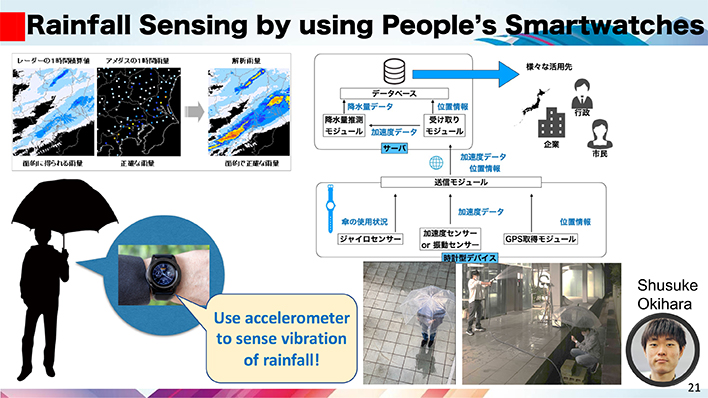
Recent information system technologies have been developed with a focus on increasing each individual’s information processing and dissemination capabilities. Sensing technology, which our laboratory is studying, also starts from knowing about individual humans and provides feedback to individuals. However, there are growing concerns that many systems of the technologies may be excessively individual-oriented. As a matter of fact, problems caused by the posting of slanderous messages on social media, which is a common occurrence these days, can be said to be arising from technologies that are excessively optimized for individuals.
I believe that there should be an information system built on the basis of altruism, rather than egocentrism, as people often feel rewarded or fulfilled when prioritizing others over themselves. For instance, people who cannot act of their own accord may act readily when requested to do so by their mother, life partner, or some other “significant other,” as the term is used in psychology. People are not always rational but they are driven by their emotions, so much so that altruism, or consideration for others, can work as a driver that encourages them to take action.
As our research subject, while maintaining the current approach to know about individuals more deeply, we will also study a system that goes beyond individuals. The system will be like one that will create and expand networks among individuals and between individuals and others or society on computers.
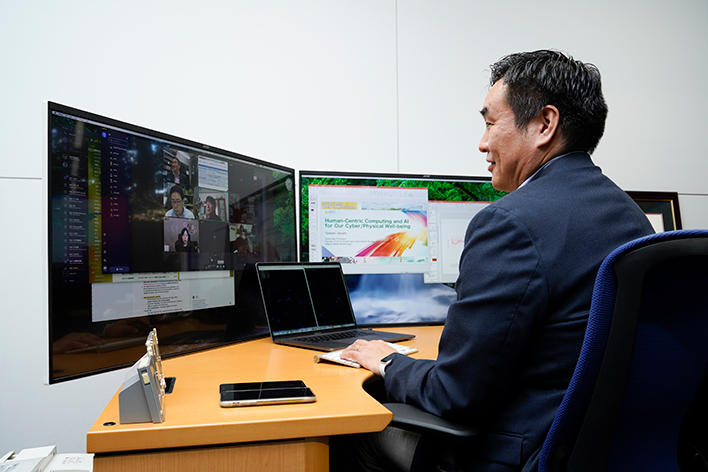

Tadashi Okoshi
Associate Professor, Faculty of Environment and Information Studies, Keio University. M.S. in Computer Science from Carnegie Mellon University and Ph.D. in Media and Governance from Keio University. Formerly an entrepreneur in the areas of blogs, social networks, and social media, an employee for a U.S. company, and a researcher at School of Information Systems in Singapore Management University and HCI Institute in Carnegie Mellon University. Has held current position since 2021.

2022.Jan ISSUE